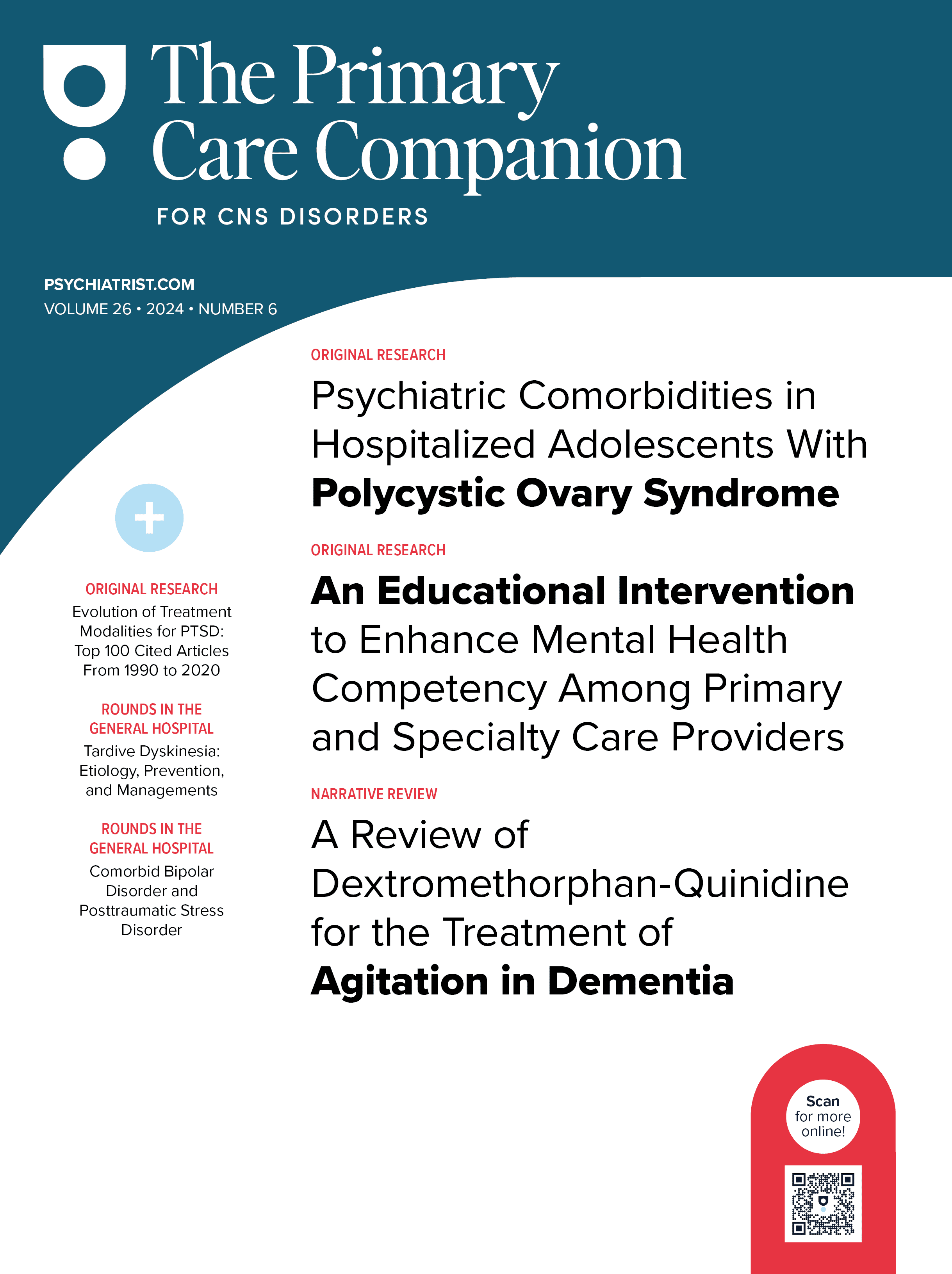aDepartment of Psychiatry, BronxCare Health System, Bronx, New York
bDepartment of Addiction Psychiatry, Yale School of Medicine, New Haven, Connecticut
*Corresponding author: Souparno Mitra, MD, 1276 Fulton Ave, 5th Floor South, Bronx, NY 10460 ([email protected]).
Prim Care Companion CNS Disord 2021;23(2):20l02738
To cite: Mitra S, Gallo Ruiz MA, Virani S, et al. A unique case of dehydration-related psychosis: witnessing a mirage in the city. Prim Care Companion CNS Disord. 2021;23(2):20l02738.
To share: https://doi.org/10.4088/PCC.20l02738
© Copyright 2021 Physicians Postgraduate Press, Inc.
The defining signs of psychosis include positive symptoms (hallucinations, delusions) and negative symptoms, which include asociality, alogia, diminished affect, and diminished motivation.1 McGrath et al2 reported a prevalence of 5% internationally for hallucinations or illusions in the general population. The etiology of psychotic disorders includes schizophrenia, schizoaffective disorders, schizophreniform disorder, psychotic disorder related to substance use, and psychotic disorder secondary to a medical condition.
Psychotic symptoms secondary to a medical condition may be seen in epilepsy, frontal or limbic neoplasms, cerebrovascular disease or trauma, acute intermittent porphyria, HIV/AIDS, vitamin B12 deficiency, carbon monoxide poisoning, cerebral lipidosis, Creutzfeld-Jakob disease, and Fabry disease.3
In this report, we discuss a unique case of brief psychotic episode related to a medical condition, for which dehydration seemed to be the most likely etiology.
Adeyeye et al4 found that in the summers of 2008–2012, emergency departments (EDs) in New York state reported 59,828 visits for dehydration. Some of the signs described in the ICD-9 code 276.51 for dehydration include excessive thirst, dark-colored urine, urinating less, dizziness and fainting, feeling tired, and dry skin.5
Case Report
Ms A is a 42-year-old Hispanic woman with no past psychiatric history or ED visits who was brought to the ED of a community hospital by emergency medical services after she was found wandering in the streets disoriented. She would not speak to anyone and had her eyes closed.
On arrival to the ED, the patient refused to speak and continued to keep her eyes closed and kept them shut when attempts were made to open them. She was mildly tachycardic. Subsequently, she opened her eyes and could remember that the ED doctor was questioning her. However, when she was asked why she did not respond, she said, “I don’t remember.” At this time, she endorsed command auditory hallucinations to kill herself. She was tachycardic with no focal neurologic signs. Her initial laboratory results were within normal limits except for a low potassium level of 3.2 mEq/L. Her sodium level was 142 mEq/L. No drugs were found in the urine toxicology screen, and she had a negative ethanol level. Computed tomography (CT) of the head was unremarkable.
She was transferred to the comprehensive psychiatric emergency program for psychiatric evaluation with no medical intervention. On initial evaluation, the patient was lethargic and incoherent. When asked about voices, Ms A said she could hear music and songs in her head. As per the nursing report on day 1, Ms A stated that she was having pain all over and that she “blacks out all the time.” That night, she was observed by the on-call psychiatrist to be acutely agitated, irritable, pacing the hallway, jumping on the table, calling names, staring intensely at the wall, yelling and screaming (“Mathew’s It” and “Accounting 201”), and making bizarre gestures. She could not be redirected and had to be emergently medicated and placed in 4-point soft restraints. She was not drinking fluids and was noted to be dehydrated on physical evaluation, with coasting of tongue and sunken eyes.
Ms A was subsequently admitted to the psychiatric floor. On initial evaluation, she continued to endorse command auditory hallucinations. She was started on low-dose risperidone to target her perceptual disturbances. She was partially compliant with the medication. Since admission, she continued to be tachycardic. The following day, she became hyperthermic and hypotensive (96/53 mm Hg). She was noted to have dryness of the tongue along with diminished skin turgor. Her serum osmolality was elevated, and she was referred to the ED wherein she was diagnosed with hypertonic dehydration, hydrated with isotonic fluids (normal saline) for the first time, stabilized, and sent back to the psychiatric floor. Table 1 provides a timeline of Ms A’s vital signs, laboratory values, and hydration status.
She continued to endorse auditory hallucinations of choir music for 1 day. Subsequently, from the next day, she denied all psychiatric symptoms. She improved her oral fluid intake. She was seen in groups interacting with peers. She was pleasant with staff and euthymic with full affect. There were no distortions in her thought process or content. Ms A had been started on a small dose of risperidone, which was stopped at time of discharge.
Collaterals from family members confirmed the absence of any psychiatric symptoms or history in the past or antecedent drug use. Ms A stated that she was in college and was living alone. Her children were living with their father and would visit her infrequently. She had been working on graduating and finding a job so that she could better support her children and herself. She also said that she had not been drinking adequate fluids, as she was stressed about upcoming college exams.
She was carefully monitored for any residual psychotic symptoms. Despite her partial compliance to medication, no psychotic symptoms were observed. Ms A submitted a letter for discharge and was not deemed to be a risk to herself or others and was discharged home with outpatient follow-up.
Discussion
This case provides an interesting and unique explanation for the patient’s psychotic symptoms. A thorough evaluation revealed no evidence of any other etiology. A comprehensive literature search using PubMed yielded no published research on this etiology other than a Danish article.6
One possible explanation for psychotic symptoms is that dehydration may lead to electrolyte imbalances due to hyponatremia caused by the body trying to maintain osmotic balance. Patients may experience sweating (losing electrolytes and fluids), and the free water may be retained due to the actions of vasopressin, leading to a relative decreased sodium concentration and subsequent hyponatremia.7 Another explanation may be hypernatremia, which has been noted to occur in dehydration due to hemoconcentration and increased osmolality as was seen in our patient.
Hyponatremia causes cerebral tissue swelling. Hypernatremia may cause dehydration of brain structures and lead to impaired neurologic functioning. Either of these electrolyte imbalances may cause alteration in neurologic functioning, which may possibly manifest as psychotic symptoms as was seen in Ms A.8
This case highlights the importance of performing a full workup of patients with first-episode psychosis, especially when they have no risk factors. Patients should be evaluated for any substance use via a comprehensive interview and urine drug screen as well as for medical conditions that may cause psychosis. The common laboratory and imaging studies that may help diagnose an etiology are CT, magnetic resonance imaging, autoantibody titers, karyotyping, drug urine screen, heavy metal screen, serum calcium, thyroid/parathyroid hormone levels, urinary catecholamines, arylsulfatase-A levels, copper and ceruloplasmin levels, vitamin B12 levels, folate levels, vitamin D3 levels, rapid plasma reagin to rule out syphilis, HIV antibody titers, glucose and protein in cerebrospinal fluid electroencephalography, and evoked potentials.9
The important criteria to consider while diagnosing dehydration include asking about fluid intake and conditions that may lead to excess fluid output (exercise, fever, diuretics, diarrhea). Important physical signs to consider for dehydration include diminished skin turgor, coasting of tongue, sunken eyes, tachycardia, orthostatic hypotension, and pale extremities. An increased urine and serum osmolality as well as electrolyte imbalances may provide clues to diagnose dehydration.10 The treatment modalities employed include correction of the fluid and electrolyte imbalance with intravenous fluids and electrolyte supplementation. One important factor to also consider is the choice of fluids to be administered. Depending on presence of hypernatremia or hyperosmolality, dextrose 5% in water or normal saline can be used.11
This case provides a unique example wherein a comprehensive workup for common medical conditions that may cause psychosis was negative, and the patient had no personal or family history of psychiatric illness or drug use. Dehydration, as the likely etiology for her psychosis, was postulated on the basis of her clinical signs, serum osmolality, and electrolyte imbalance. Also, her psychotic symptoms resolved rapidly with rehydration and symptomatic management of her dehydration, which further strengthened the hypothesis.
Conclusion
This case provides anecdotal evidence that dehydration may lead to psychosis. Research on this etiology is limited, and further studies and hypothesis testing may further strengthen this evidence. Until then, psychiatrists should definitely look out for any evidence of dehydration during the general medical examination in patients who present with first-episode psychotic symptoms.
Published online: April 15, 2021.
Potential conflicts of interest: None.
Funding/support: None.
Previous presentation: The case was accepted for presentation at the American Psychiatric Association Annual Meeting; April 25–29, 2020; Philadelphia, Pennsylvania.
Patient consent: Consent was received from the patient to publish the case report, and information has been de-identified to protect anonymity.
References (11)

- American Psychiatric Association. Diagnostic and Statistical Manual for Mental Disorders. Fifth Edition. Washington, DC: American Psychiatric Association; 2013.
- McGrath JJ, Saha S, Al-Hamzawi A, et al. Psychotic experiences in the general population: a cross-national analysis based on 31,261 respondents from 18 countries. JAMA Psychiatry. 2015;72(7):697–705. PubMed CrossRef
- Sarkhel S. Kaplan and Sadock’s Synopsis of Psychiatry: Behavioral Sciences/Clinical Psychiatry, 10th edition. Indian J Psychiatry. 2009;51(4):331.
- Adeyeye TE, Insaf TZ, Al-Hamdan MZ, et al. Estimating policy-relevant health effects of ambient heat exposures using spatially contiguous reanalysis data. Environ Health. 2019;18(1):35. PubMed CrossRef
- ICD-9-CM: International Classification of Diseases, 9th Revision, Clinical Modification. Salt Lake City, Utah: Medicode; 1996.
- Abrahamson IA Sr, Abrahamson IA Jr. Dehydration-a cause of psychosis following cataract extraction. Eye Ear Nose Throat Mon. 1968;47(3):144–146. PubMed
- Montain SJ, Sawka MN, Wenger CB. Hyponatremia associated with exercise: risk factors and pathogenesis. Exerc Sport Sci Rev. 2001;29(3):113–117. PubMed CrossRef
- Jana DK, Romano-Jana L. Hypernatremic psychosis in the elderly: case reports. J Am Geriatr Soc. 1973;21(10):473–477. PubMed CrossRef
- Keshavan MS, Kaneko Y. Secondary psychoses: an update. World Psychiatry. 2013;12(1):4–15. PubMed CrossRef
- Hooper L, Abdelhamid A, Attreed NJ, et al. Clinical symptoms, signs and tests for identification of impending and current water-loss dehydration in older people. Cochrane Database Syst Rev. 2015;2015(4):CD009647. PubMed
- Strachan SR, Morris LF. Management of severe dehydration. J Intensive Care Soc. 2017;18(3):251–255. PubMed CrossRef
Please sign in or purchase this PDF for $40.
Save
Cite





